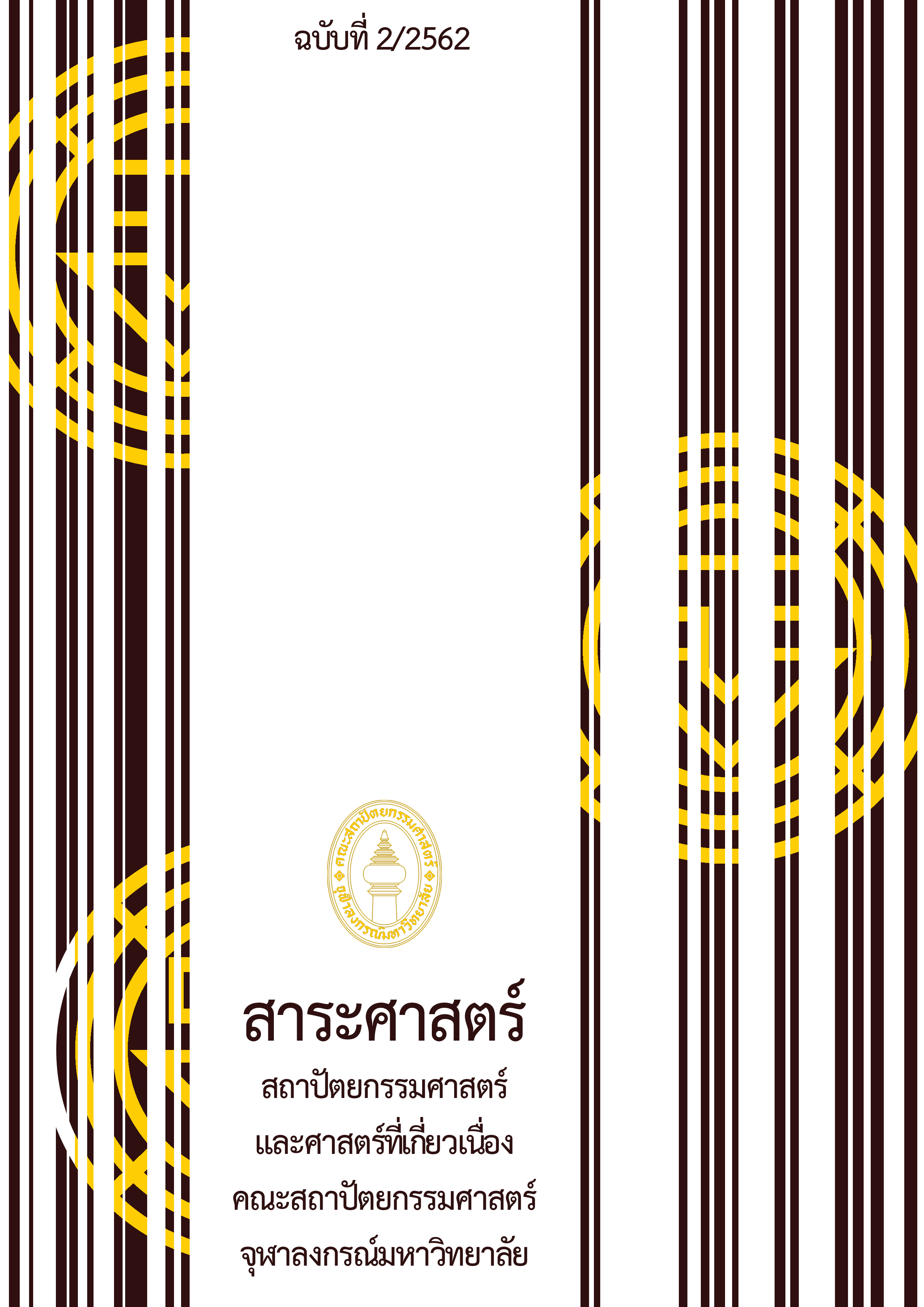Analysis of Chao Phraya Delta Structure and Change
Main Article Content
Abstract
The Chao Phraya Delta is a result of fluvial process and deposit. In the rainy season, the whole area is covered by the water. And after the rainy season ends, the water has disappeared. This seasonal flood brings the abundance to this area. But in the present, the development in this area such as the urbanization, the flood wall protection project including the irrigation development project that are the cause of the Chao Phraya Delta’s water regime changes.
This study has a purpose to analysis the Chao Phraya Delta structure and studies the landscape change in the Chao Phraya Delta by using the geographic information system (GIS) and satellite image analysis. The process to analyze the satellite image include color composition and image enhancement by band operation. Band operation that uses in this study is Normalized Built-up Area Index to enhance the built-up area and detect the land cover change to define the problem that is the result of landscape structure change
The result of this study is the urban area is explored into the lowland. The land cover had changed from the paddy field to the built-up area. So, it reduces the catchment area where floods can be diverted and mitigated. Moreover, the irrigation development has separated the area like a polder to water management. It blocks the flood flow and controls the excess flows to be concentrated in the irrigation or drainage channel. These are a cause of the flood inundation became a flood disaster in this area. So, the development in Chao Phraya Delta, the issue that should be considered is the space for the flood to make an urban that related to the dynamics of this area.
Article Details
References
Google Earth 7.3. “Chao Phraya Delta, 14°34'19.07"N, 100°151'131.152"E,Eelevation 100 M, Eye alt547.148 km, 103D Map, Buildings Data Layer.” Accessed May 13, 2019. https://www.google.com/earth/index.html.
Haruyama, S. “Geomorphology of the Central Plain of Thailand and its Relationship with Recent Flood Conditions.” GeoJournal 31, 4(1993): 327-334.
Hubbard, R. V. “Canal Construction in the Chao Phraya River System, Central Thailand.” In
The History of Inland Waterway Development in Thailand, R. V. Hubbard and J. A. Hafner, (eds.). Ann Arbor, MI.: The Department of Geography and the Center for South and Southeast Asian Studies, University of Michigan, 1977.
Jarupongsakul, T. and Kaida, Y. “The Imagescape of the Chao Phraya Delta into the Year 2020.” In The Chao Phraya Delta: Historical Development, Dynamics and Challenges of Thailand's Rice Bowl, 461-499. Bangkok: Kasetsart University, 2000.
Junk, W. J., Bayley, P. B. and Sparks, R. E. “The Flood Pulse Concept in River—Floodplain Systems.” In
Proceedings of the International Large River Symposium (LARS), D. P. Dodge (ed.), 110-127.
Ontario: Canadian Special Publication of Fisheries and Aquatic Sciences 106, 1989.
Kaida, Y. “A Subdivision of the Chao Phraya Delta in Thailand Based on Hydrographical Conditions: Water Condition in Deltaic Lowland Rice Fields(I).” Southeast Asian Studies 11, 3 (1973): 403-413.
Kasetsart University and ORSTOM. Agricultural and Irrigation Patterns in the Central Plain of Thailand : Preliminary Analysis and Prospects for Agricultural Research and Development. Bangkok: DORAS Project, 1996.
Molle, F. “Water Management and Agricultural Change: A Case Study in the Upper Chao Phraya Delta.” Southeast Asian Studies 36, 1(1998): 32-58.
Molle, F., Sripen Durongdej, Chatchom Chompadist, Joannon, A. and Yuphaa Limsawad. Improvement of Rrice Cultivation and Water Management in the Flooded Area of the Central Plain of Thailand : A Zoning of Rrice Systems by Using Remote Sensing Imagery. Bangkok: DORAS Project, Kasetsart University, 1999.
Noppadol Phienwej and Prinya Nutalaya. “Subsidence and Flooding in Bangkok.” In The Physical Geography of Southeast Asia, A. Gupta (ed.), Oxford: Oxford University Press, 2005.
Pal, M., and Antil, K. “COMPARISON OF LANDSAT 8 AND SENTINEL 2 DATA FOR ACCURATE MAPPING OF BUILT-UP AREA AND BARE SOIL.” In 38th Asian Conference on Remote Sensing (ACRS 2017): Space Applications: Touching Human Lives Paper,137-140. New York: Curran Associates, 2017.
Sinsakul, Sin. “Late Quaternary Geology of the Lower Central Plain, Thailand.” Journal of Asian Earth Sciences 18, 4 (2000): 415-426.
Takaya, Y. Agricultural Development of A Tropical Delta : A Study of the Chao Phraya Delta Translate by P. Hawkes. Kyoto: Kyoto University, 1987.
Takaya, Y.“Rice Cropping Patterns in Southern Asian Delta.” Southeast Asian Studies 13, 2(1975): 256-281.
Takaya, Y.“Rice Growing Societies of Asia: an Ecological Approach.” Southeast Asian Studies 15, 3 (1977): 442-451.
Takaya, Y.“Topographical Analysis of the Southern Basin of the Central Plain, Thailand.” The Southeast Asian Studies 7, 3 (1969): 293-300.
Tanabe, S. Ecology and Practical Technology : Peasant Farming System in Thailand. Bangkok: White Lotus, 1994.
United States Geological Survey. “What are the Band Designations for the Landsat Satellites?” Accessed May 7, 2019. https://www.usgs.gov/faqs/what-are-band-designations-landsat-satellites?qt-news_science_products=7#qt-news_science_products.
Waqar, M. M., Mirza, J. F., Mumtaz, R., and Hussain, E. “Development of New Indices for Extraction of Built-Up Area & Bare Soil from Landsat Data.” Open Access Scientific Report 1, 1 (2012): 136.
ตรงใจ หุตางกูร. “การตีความใหม่เรื่อง ขอบเขตแนวชายฝั่งทะเลโบราณสมัยทวารวดีบนที่ราบภาคกลางตอนล่าง.” ดำรงวิชาการ 13, 1(2557): 11-44.
มิ่งขวัญ นันทวิสัย. “การจำแนกและวิเคราะห์พืชพรรณในเมืองเพื่อหาความสัมพันธ์ของรูปแบบพืชพรรณในเมืองที่มีผลต่ออุณหภูมิผิวพื้นของเมือง: กรณีศึกษา กรุงเทพมหานคร.” วิทยานิพนธ์ปริญญามหาบัณฑิต ภาควิชาภูมิสถาปัตยกรรม คณะสถาปัตยกรรมศาสตร์ จุฬาลงกรณ์มหาวิทยาลัย, 2559.
ศรีศักร วัลลิโภดม. “สังคมลุ่มแม่น้ำเจ้าพระยา : พัฒนาการและการเปลี่ยนแปลง.” ใน ลุ่มเจ้าพระยา รากเหง้าแห่งสยามประเทศ,
ศรีศักร วัลลิโภดม และ วลัยลักษณ์ ทรงศิริ, (บรรณาธิการ). กรุงเทพฯ: มูลนิธิเล็ก-ประไพ วิริยะพันธุ์, 2560.
สมพร สง่าวงศ์. การสำรวจจากระยะไกลในด้านการใช้ประโยชน์ที่ดิน/สิ่งปกคลุมดินและการประยุกต์. พิมพ์ครั้งที่ 1. กรุงเทพฯ: สำนักพิมพ์แห่งจุฬาลงกรณ์มหาวิทยาลัย, 2552.


